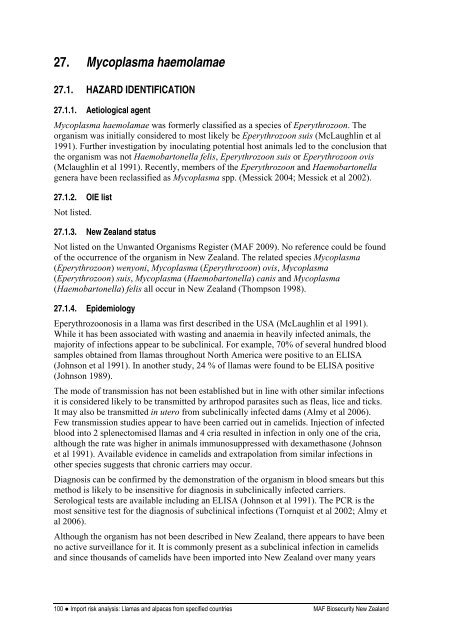Import risk analysis: Llamas (Lama glama) and alpacas (Vicugna ...
Import risk analysis: Llamas (Lama glama) and alpacas (Vicugna ...
Import risk analysis: Llamas (Lama glama) and alpacas (Vicugna ...
You also want an ePaper? Increase the reach of your titles
YUMPU automatically turns print PDFs into web optimized ePapers that Google loves.
27. Mycoplasma haemolamae<br />
27.1. HAZARD IDENTIFICATION<br />
27.1.1. Aetiological agent<br />
Mycoplasma haemolamae was formerly classified as a species of Eperythrozoon. The<br />
organism was initially considered to most likely be Eperythrozoon suis (McLaughlin et al<br />
1991). Further investigation by inoculating potential host animals led to the conclusion that<br />
the organism was not Haemobartonella felis, Eperythrozoon suis or Eperythrozoon ovis<br />
(Mclaughlin et al 1991). Recently, members of the Eperythrozoon <strong>and</strong> Haemobartonella<br />
genera have been reclassified as Mycoplasma spp. (Messick 2004; Messick et al 2002).<br />
27.1.2. OIE list<br />
Not listed.<br />
27.1.3. New Zeal<strong>and</strong> status<br />
Not listed on the Unwanted Organisms Register (MAF 2009). No reference could be found<br />
of the occurrence of the organism in New Zeal<strong>and</strong>. The related species Mycoplasma<br />
(Eperythrozoon) wenyoni, Mycoplasma (Eperythrozoon) ovis, Mycoplasma<br />
(Eperythrozoon) suis, Mycoplasma (Haemobartonella) canis <strong>and</strong> Mycoplasma<br />
(Haemobartonella) felis all occur in New Zeal<strong>and</strong> (Thompson 1998).<br />
27.1.4. Epidemiology<br />
Eperythrozoonosis in a llama was first described in the USA (McLaughlin et al 1991).<br />
While it has been associated with wasting <strong>and</strong> anaemia in heavily infected animals, the<br />
majority of infections appear to be subclinical. For example, 70% of several hundred blood<br />
samples obtained from llamas throughout North America were positive to an ELISA<br />
(Johnson et al 1991). In another study, 24 % of llamas were found to be ELISA positive<br />
(Johnson 1989).<br />
The mode of transmission has not been established but in line with other similar infections<br />
it is considered likely to be transmitted by arthropod parasites such as fleas, lice <strong>and</strong> ticks.<br />
It may also be transmitted in utero from subclinically infected dams (Almy et al 2006).<br />
Few transmission studies appear to have been carried out in camelids. Injection of infected<br />
blood into 2 splenectomised llamas <strong>and</strong> 4 cria resulted in infection in only one of the cria,<br />
although the rate was higher in animals immunosuppressed with dexamethasone (Johnson<br />
et al 1991). Available evidence in camelids <strong>and</strong> extrapolation from similar infections in<br />
other species suggests that chronic carriers may occur.<br />
Diagnosis can be confirmed by the demonstration of the organism in blood smears but this<br />
method is likely to be insensitive for diagnosis in subclinically infected carriers.<br />
Serological tests are available including an ELISA (Johnson et al 1991). The PCR is the<br />
most sensitive test for the diagnosis of subclinical infections (Tornquist et al 2002; Almy et<br />
al 2006).<br />
Although the organism has not been described in New Zeal<strong>and</strong>, there appears to have been<br />
no active surveillance for it. It is commonly present as a subclinical infection in camelids<br />
<strong>and</strong> since thous<strong>and</strong>s of camelids have been imported into New Zeal<strong>and</strong> over many years<br />
100 ● <strong>Import</strong> <strong>risk</strong> <strong>analysis</strong>: <strong>Llamas</strong> <strong>and</strong> <strong>alpacas</strong> from specified countries MAF Biosecurity New Zeal<strong>and</strong>

















